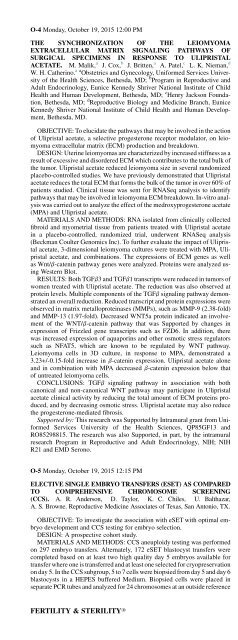Create successful ePaper yourself
Turn your PDF publications into a flip-book with our unique Google optimized e-Paper software.
O-4 Monday, <strong>October</strong> 19, <strong>2015</strong> 12:00 PM<br />
THE SYNCHRONIZATION OF THE LEIOMYOMA<br />
EXTRACELLULAR MATRIX SIGNALING PATHWAYS OF<br />
SURGICAL SPECIMENS IN RESPONSE TO ULIPRISTAL<br />
ACETATE. M. Malik, a J. Cox, b J. Britten, a A. Patel, c L. K. Nieman, d<br />
W. H. Catherino. a a Obstetrics and Gynecology, Uniformed Services University<br />
of the Health Sciences, Bethesda, MD; b Program in Reproductive and<br />
Adult Endocrinology, Eunice Kennedy Shriver National Institute of Child<br />
Health and Human Development, Bethesda, MD; c Henry Jackson Foundation,<br />
Bethesda, MD; d Reproductive Biology and Medicine Branch, Eunice<br />
Kennedy Shriver National Institute of Child Health and Human Development,<br />
Bethesda, MD.<br />
OBJECTIVE: To elucidate the pathways that may be involved in the action<br />
of Ulipristal acetate, a selective progesterone receptor modulator, on leiomyoma<br />
extracellular matrix (ECM) production and breakdown.<br />
DESIGN: Uterine leiomyomas are characterized by increased stiffness as a<br />
result of excessive and disordered ECM which contributes to the total bulk of<br />
the tumor. Ulipristal acetate reduced leiomyoma size in several randomized<br />
placebo-controlled studies. We have previously demonstrated that Ulipristal<br />
acetate reduces the total ECM that forms the bulk of the tumor in over 60% of<br />
patients studied. Clinical tissue was sent for RNASeq analysis to identify<br />
pathways that may be involved in leiomyoma ECM breakdown. In-vitro analysis<br />
was carried out to analyze the effect of the medroxyprogesterone acetate<br />
(MPA) and Ulipristal acetate.<br />
MATERIALS AND METHODS: RNA isolated from clinically collected<br />
fibroid and myometrial tissue from patients treated with Ulipristal acetate<br />
in a placebo-controlled, randomized trial, underwent RNASeq analysis<br />
(Beckman Coulter Genomics Inc). To further evaluate the impact of Ulipristal<br />
acetate, 3-dimensional leiomyoma cultures were treated with MPA, Ulipristal<br />
acetate, and combinations. The expressions of ECM genes as well<br />
as Wnt/b-catenin pathway genes were analyzed. Proteins were analyzed using<br />
Western Blot.<br />
RESULTS: Both TGFb3 and TGFb1 transcripts were reduced in tumors of<br />
women treated with Ulipristal acetate. The reduction was also observed at<br />
protein levels. Multiple components of the TGFb signaling pathway demonstrated<br />
an overall reduction. Reduced transcript and protein expressions were<br />
observed in matrix metalloproteinases (MMPs), such as MMP-9 (2.38-fold)<br />
and MMP-13 (1.97-fold). Decreased WNT5a protein indicated an involvement<br />
of the WNT/b-catenin pathway that was Supported by changes in<br />
expression of Frizzled gene transcripts such as FZD6. In addition, there<br />
was increased expression of aquaporins and other osmotic stress regulators<br />
such as NFAT5, which are known to be regulated by WNT pathway.<br />
Leiomyoma cells in 3D culture, in response to MPA, demonstrated a<br />
3.23+/-0.15-fold increase in b-catenin expression. Ulipristal acetate alone<br />
and in combination with MPA decreased b-catenin expression below that<br />
of untreated leiomyoma cells.<br />
CONCLUSIONS: TGFb signaling pathway in association with both<br />
canonical and non-canonical WNT pathway may participate in Ulipristal<br />
acetate clinical activity by reducing the total amount of ECM proteins produced,<br />
and by decreasing osmotic stress. Ulipristal acetate may also reduce<br />
the progesterone-mediated fibrosis.<br />
Supported by: This research was Supported by Intramural grant from Uniformed<br />
Services University of the Health Sciences, QP85GF13 and<br />
RO85298815. The research was also Supported, in part, by the intramural<br />
research Program in Reproductive and Adult Endocrinology, NIH; NIH<br />
R<strong>21</strong> and EMD Serono.<br />
O-5 Monday, <strong>October</strong> 19, <strong>2015</strong> 12:15 PM<br />
ELECTIVE SINGLE EMBRYO TRANSFERS (ESET) AS COMPARED<br />
TO COMPREHENSIVE CHROMOSOME SCREENING<br />
(CCS). A. R. Anderson, D. Taylor, K. C. Chiles, U. Balthazar,<br />
A. S. Browne. Reproductive Medicine Associates of Texas, San Antonio, TX.<br />
OBJECTIVE: To investigate the association with eSET with optimal embryo<br />
development and CCS testing for embryo selection.<br />
DESIGN: A prospective cohort study.<br />
MATERIALS AND METHODS: CCS aneuploidy testing was performed<br />
on 297 embryo transfers. Alternately, <strong>17</strong>2 eSET blastocyst transfers were<br />
completed based on at least two high quality day 5 embryos available for<br />
transfer where one is transferred and at least one selected for cryopreservation<br />
on day 5. In the CCS subgroup, 5 to 7 cells were biopsied from day 5 and day 6<br />
blastocysts in a HEPES buffered Medium. Biopsied cells were placed in<br />
separate PCR tubes and analyzed for 24 chromosomes at an outside reference<br />
laboratory. All embryos in the CCS subgroup were subjected to vitrification<br />
for a delayed embryo transfer in a subsequent frozen embryo cycle.<br />
RESULTS: There was no significant difference in ongoing pregnancy,<br />
average age, embryos transferred, or miscarriage rates when eSET criterion<br />
or CCS was utilized for embryo selection. In the eSET group there were <strong>17</strong>2<br />
transfers with 126 (73%) positive pregnancies, 25 (20%) losses, and 101<br />
(59%) ongoing pregnancies. From 297 CCS embryo transfers there were<br />
209 (70%) positive pregnancies, 47 (22%) losses, and 162 (54%) ongoing<br />
pregnancies respectively with no significant difference between these two<br />
subgroups. However, there was a significant (P


